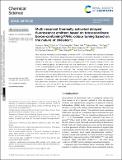Files in this item
Multi-resonant thermally activated delayed fluorescence emitters based on tetracoordinate boron-containing PAHs : colour tuning based on the nature of chelates
Item metadata
| dc.contributor.author | Meng, Guoyun | |
| dc.contributor.author | Liu, Lijie | |
| dc.contributor.author | He, Zhechang | |
| dc.contributor.author | Hall, David | |
| dc.contributor.author | Wang, Xiang | |
| dc.contributor.author | Peng, Tai | |
| dc.contributor.author | Yin, Xiaodong | |
| dc.contributor.author | Chen, Pangkuan | |
| dc.contributor.author | Beljonne, David | |
| dc.contributor.author | Olivier, Yoann | |
| dc.contributor.author | Zysman-Colman, Eli | |
| dc.contributor.author | Wang, Nan | |
| dc.contributor.author | Wang, Suning | |
| dc.date.accessioned | 2022-02-02T12:30:09Z | |
| dc.date.available | 2022-02-02T12:30:09Z | |
| dc.date.issued | 2022-01-04 | |
| dc.identifier | 277693016 | |
| dc.identifier | a972e74c-8fd5-42d5-9eda-41f561fa0e7d | |
| dc.identifier | 000744599000001 | |
| dc.identifier | 85124688776 | |
| dc.identifier.citation | Meng , G , Liu , L , He , Z , Hall , D , Wang , X , Peng , T , Yin , X , Chen , P , Beljonne , D , Olivier , Y , Zysman-Colman , E , Wang , N & Wang , S 2022 , ' Multi-resonant thermally activated delayed fluorescence emitters based on tetracoordinate boron-containing PAHs : colour tuning based on the nature of chelates ' , Chemical Science , vol. Advance Article , no. 6 . https://doi.org/10.1039/d1sc05692a | en |
| dc.identifier.issn | 2041-6520 | |
| dc.identifier.other | Jisc: cdbba5db4e954ff18cc074351f9b2008 | |
| dc.identifier.other | ORCID: /0000-0001-7183-6022/work/107718253 | |
| dc.identifier.uri | https://hdl.handle.net/10023/24790 | |
| dc.description | The St Andrews team would like to thank the Leverhulme Trust (RPG-2016-047) and EPSRC (EP/P010482/1) for financial support. E. Z.-C. is a Royal Society Leverhulme Trust Senior Research fellow (SRF\R1\201089). | en |
| dc.description.abstract | Multi-resonant thermally activated delayed fluorescence (MR-TADF) materials have attracted considerable attention recently. The molecular design frequently incorporates cycloboration. However, to the best of our knowledge MR-TADF compounds containing nitrogen chelated to boron are still unknown. Reported herein is a new class of tetracoordinate boron-containing MR-TADF emitters bearing C^N^C- and N^N^N-chelating ligands. We demonstrate that the replacement of the B–C covalent bond in the C^N^C-chelating ligand by the B–N covalent bond affords an isomer, which dramatically influences the optoelectronic properties of the molecule. The resulting N^N^N-chelating compounds show bathochromically shifted absorption and emission spectra relative to C^N^C-chelating compounds. The incorporation of a tert-butylcarbazole group at the 4-position of the pyridine significantly enhances both the thermal stability and the reverse intersystem crossing rate, yet has a negligible effect on emission properties. Consequently, high-performance hyperfluorescent organic light-emitting diodes (HF-OLEDs) that utilize these molecules as green and yellow-green emitters show a maximum external quantum efficiency (ηext) of 11.5% and 25.1%, and a suppressed efficiency roll-off with an ηext of 10.2% and 18.7% at a luminance of 1000 cd m−2, respectively. | |
| dc.format.extent | 10 | |
| dc.format.extent | 1374152 | |
| dc.language.iso | eng | |
| dc.relation.ispartof | Chemical Science | en |
| dc.subject | QD Chemistry | en |
| dc.subject | DAS | en |
| dc.subject | MCC | en |
| dc.subject.lcc | QD | en |
| dc.title | Multi-resonant thermally activated delayed fluorescence emitters based on tetracoordinate boron-containing PAHs : colour tuning based on the nature of chelates | en |
| dc.type | Journal article | en |
| dc.contributor.sponsor | The Leverhulme Trust | en |
| dc.contributor.sponsor | EPSRC | en |
| dc.contributor.sponsor | The Royal Society | en |
| dc.contributor.institution | University of St Andrews. EaSTCHEM | en |
| dc.contributor.institution | University of St Andrews. School of Chemistry | en |
| dc.identifier.doi | 10.1039/d1sc05692a | |
| dc.description.status | Peer reviewed | en |
| dc.identifier.grantnumber | RPG-2016-047 | en |
| dc.identifier.grantnumber | EP/P010482/1 | en |
| dc.identifier.grantnumber | SRF\R1\201089 | en |
This item appears in the following Collection(s)
Items in the St Andrews Research Repository are protected by copyright, with all rights reserved, unless otherwise indicated.

